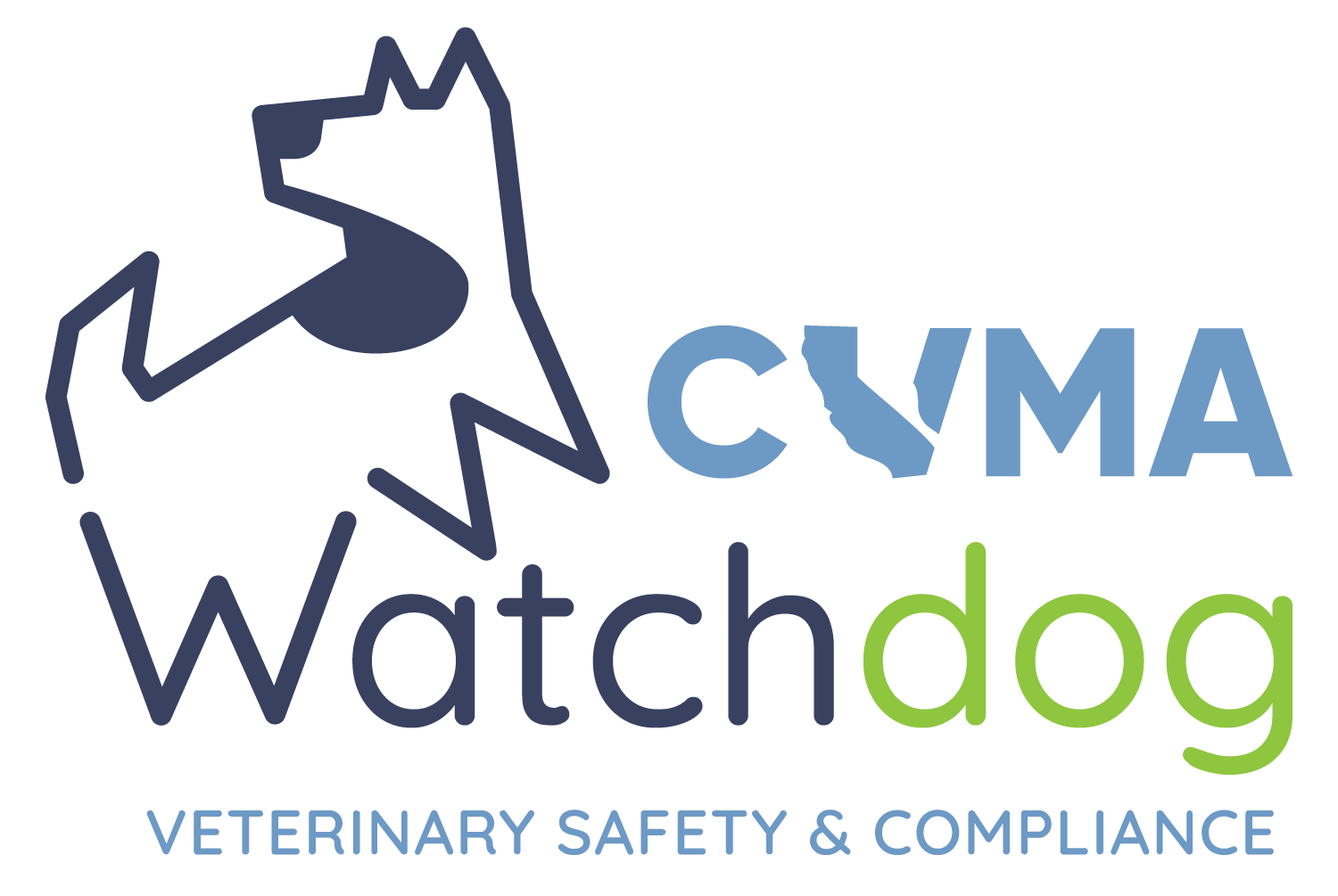- What is a controlled substance?
A controlled substance is a drug or chemical whose manufacture, possession, or use is regulated by a government and are thus subject of legislative control. Generally, a controlled substance has a potential for diversion and/or abuse because its use may lead to physical and/or psychological dependence.
- How do I know whether or not a drug is a controlled substance?
Controlled substances are clearly marked with a “C” on the vial, syringe, or container that they are packaged in by the manufacturer. If you are unsure as to whether or not a substance in controlled, you can also check the Federal Controlled Substances Act (CSA) drug schedules. There are 5 schedules, and generally veterinarians utilize medications from Schedules II-IV. Current CSA Schedules are available here. - Who has ultimate jurisdictional authority over controlled substances?
The Federal Drug Enforcement Agency (DEA). Most commonly, we interact with the DEA Office of Diversion Control. - What does the DEA do?
In relation to veterinary practices, the Federal Drug Enforcement Agency Office of Diversion Control (DEA) enforces the Federal Controlled Substances Act (CSA) through registration monitoring, investigation and enforcement in what is referred to as a “closed regulatory system.” This means that the DEA strives to keep account of the whereabouts and use of all controlled substances by registrants at all times. For more detail, read CVMA’s article titled “DEA at a Glance.” - How do I obtain DEA registration?
Only licensed veterinarians are qualified to obtain DEA registration. It is recommended that all licensed veterinarians obtain a DEA registration number. A registration number will enable you to obtain controlled substances, administer them to patients, dispense them to clients for use in animal patients, and write prescriptions that clients may have filled at a pharmacy of their choice. To apply for a DEA registration number, complete DEA Form 224 here. - What am I required to do in order for my staff to be able to access and handle controlled substances in my practice?
For veterinarians and registered veterinary technicians, you are not required to do anything. As a condition of licensure, all veterinarians and registered veterinary technicians are fingerprinted and background checked.For veterinary assistants, state law requires that they obtain a Veterinary Assistant Controlled Substance Permit (VACSP) from the California Veterinary Medical Board (CVMB) prior to obtaining any controlled substances. The CVMA offers a simple step-by-step guide to assist Veterinary Assistants in getting a VACSP. Read more about the VACSP here. - Where can I find a current copy of the DEA controlled substance schedules?
Current lists are available for all five CSA schedules on the DEA website (www.usdeadiversion.usdoj.gov) under the “Resources” tab. Access them by clicking here. - What are the storage requirements for controlled substances? The Controlled Substances Act (Code of Federal Regulations, Title 21, Section 1301.75b) states that, “Controlled substances shall be stored in a securely locked, substantiallyconstructed cabinet.” But this is only part of the requirement. The registrant must take into account several factors in determining the degree of security needed to satisfy due diligence in relation to ensuring secure storage of controlled substances. The DEA Practitioner’s Manual
The Controlled Substances Act (Code of Federal Regulations, Title 21, Section 1301.75b) states that, “Controlled substances shall be stored in a securely locked, substantially constructed cabinet.”
1. The location of the premises and the relationship such location bears on security needs.
2. The type of building and office construction.
3. The type and quantity of controlled substances stored on the premises.
4. The type of storage medium (safe, vault, or steel cabinet).
5. The control of public access to the facility.
6. The adequacy of registrant’s monitoring system (alarms and detection systems).
7. The availability of local police protection.
- What are the main recordkeeping requirements for controlled
substances?
The DEA requires that you maintain controlled substance disposition logs for all scheduled drugs that you administer (use in practice) or dispense (give to clients out of your practice stock). The log may be either printed, in the form of a binder that is kept with the controlled substances, or electronic. If you decide to rely on your computer system to record controlled substance use and dispensation, the system must be able to quickly and easily generate accurate reports for each controlled substance for up to two years prior. See question #10 below. In addition to controlled substance logs, the DEA also requires that you maintain a biennial controlled substance inventory sheet which is updated a minimum of every two years. See question #11 below.
- Where can I find a DEA compliant controlled substance log?
A link to a DEA compliant controlled substance dispensing log can be accessed here.
11. What is a biennial controlled substance inventory log, and do I need
to have one?
All DEA registrants are required to keep a biennial controlled substance inventory log along with their controlled substance logs. The biennial log is an overall inventory of all controlled substances that the practice has received and utilized. Each controlled substance needs to be inventoried recorded at a minimum of every two years. The CVMA actually recommends that the biennial controlled substance log be updated whenever a new shipment of a controlled substance is received into practice stock. A biennial controlled substance inventory log may be accessed here.
12. How long must I retain controlled substance logs?
Controlled substance logs (both disposition and biennial) must be retained for a minimum of two years.
- What are the special requirements for Schedule II controlled substances?
Because of the high addiction and abuse potential of Schedule II controlled substances, the law specifies the following special stipulations for them:1. All schedule II controlled substance disposition logs will be kept separately from schedule III-V logs. This means that if you are using a binder to store your DEA logs, separate logs for each of your schedule II substances need to be kept in their own section of the binder through use of a binder divider tab. Alternatively, they can be kept in a separate binder altogether if you prefer.
2. Schedule II prescriptions may not be refilled. Prescribers should mark zero (0) or no refills (NR). In other words- there is a “one script, one fill” rule in place for all schedule II controlled substances.
3. Schedule II prescriptions may not be orally transmitted or faxed. They must be written and presented to a pharmacist in original form.
14. How much of a schedule II controlled substance can I prescribe?
While Federal law (21 CFR 1306.12(b)(1),) permits a up to a 90-day supply of a schedule II controlled substance to be prescribed, California state law limits a single prescription to 30-days. Refills on schedule II controlled substance prescriptions are prohibited, which means a “one prescription-one fill” rule must be followed.
15. Can I issue several prescriptions for a Schedule II controlled substance in advance and just give them to the client all at once?
Here is what the DEA Practitioners Manual says about issuing Schedule II prescriptions in advance:
Issuance of Multiple Prescriptions for Schedule II Substances
DEA has revised its regulations regarding the issuance of multiple prescriptions for schedule II controlled substances. Under the new regulation, which became effective December 19, 2007, an individual practitioner may issue multiple prescriptions authorizing the patient to receive a total of up to a 90-day supply of a schedule II controlled substance provided the following conditions are met:
1. Each separate prescription is issued for a legitimate medical purpose by an individual practitioner acting in the usual course of professional practice.
2. The individual practitioner provides written instructions on each prescription (other than the first prescription, if the prescribing practitioner intends for that prescription to be filled immediately) indicating the earliest date on which a pharmacy may fill each prescription.
3. The individual practitioner concludes that providing the patient with multiple prescriptions in this manner does not create an undue risk of diversion or abuse.
4. The issuance of multiple prescriptions is permissible under applicable state laws.
5. The individual practitioner complies fully with all other applicable requirements under the Controlled Substances Act and Code of Federal Regulations, as well as any additional requirements under state law.
16. How much of a schedule III-V controlled substance can I prescribe?
Schedules III and IV controlled substances may be refilled if authorized on the original prescription or by oral authorization of the practitioner. The prescription may be refilled only up to five times within six months after the date of issue. A practitioner must issue a new and separate prescription for additional quantities beyond the five-refill, six-month limitation. 21
U.S.C. 829(b), 21 CFR 1306.22(e)(4). The Controlled Substances Act (CSA) and DEA regulations do not address limits for a schedule V controlled substance refills. The CSA only provides that a schedule V controlled substance may not be distributed or dispensed other than for a medical purpose. 21 U.S.C. 829(c). Consequently, a refill for a schedule V controlled substance is issued by a practitioner for a legitimate medical purpose acting in the usual course of their professional practice.
17. How much of a schedule III-V controlled substance can I dispense (meaning- give to a client out of my hospital’s stock)?
Veterinarians may dispense up to a one-year supply of a schedule III-V controlled substance (from hospital stock). It should be noted that California Business and Professions Code section 4828.6(i)(1) states: “A veterinarian shall not prescribe a drug for a duration of time that is inconsistent with the medical condition of the animal patient or the type of drug prescribed.”
18. What happened to the old “triplicate prescription forms” used to
provide a written prescription for controlled substances?
As of January 1, 2005, veterinarians and other prescribers are required to use new tamper- resistant prescription forms with built in security features to prescribe controlled substances. Unlike the old state-issued triplicate forms available only from the Department of Justice, the new prescription forms can be ordered from an approved printing company. They can be used for any controlled substance listed in Schedules II though V and also can be used for non-scheduled prescription products.
19. What has to be on a controlled substance prescription?
According to the California Health and Safety Code Section 11162.1, a controlled substance prescription must have the following:
(a)(1) A latent, repetitive “void” pattern shall be printed across the entire front of the prescription blank; if a prescription is scanned or photocopied, the word “void” shall appear in a pattern across the entire front of the prescription.
(2) A watermark shall be printed on the backside of the prescription blank; the watermark shall consist of the words “California Security Prescription.”
(3) A chemical void protection that prevents alteration by chemical washing.
(4) A feature printed in thermochromic ink.
(5) An area of opaque writing so that the writing disappears if the prescription is lightened.
(6) A description of the security features included on each prescription form.
(7) (A) Six quantity check off boxes shall be printed on the form so that the prescriber may indicate the quantity by checking the applicable box where the following quantities shall appear:
__ 1-24
__ 25-49
__ 50-74
__ 75-100
__ 101-150
__ 151 and over
(B) In conjunction with the quantity boxes, a space shall be provided to designate the units referenced in the quantity boxes when the drug is not in tablet or capsule form.
(8) Prescription blanks shall contain a statement printed on the bottom of the prescription blank that the “Prescription is void if the number of drugs prescribed is not noted.”
(9) The preprinted name, category of licensure, license number, federal controlled substance registration number, and address of the prescribing practitioner.
(10) Check boxes shall be printed on the form so that the prescriber may indicate the number of refills ordered.
(11) The date of origin of the prescription.
(12) A check box indicating the prescriber’s order not to substitute.
(13) An identifying number assigned to the approved security printer by the Department of Justice.
(14) (A) A check box by the name of each prescriber when a prescription form lists multiple prescribers.
(15) A uniquely serialized number, in a manner prescribed by the Department of Justice.
(B) Each prescriber who signs the prescription form shall identify himself or herself as the prescriber by checking the box by his or her name.
(b) Each batch of controlled substance prescription forms shall have the lot number printed on the form and each form within that batch shall be numbered sequentially beginning with the numeral one.
20. How long is a controlled substance prescription valid?
Since January 1, 2004, prescriptions for all controlled substances (Schedules II–V) are valid for six months from the date written.
21. If I dispense controlled substances to clients, what has to be on the label?
According to Title 21 of the Code of Federal Regulations, Section 290.5 :
The label of any drug listed as a “controlled substance” in schedule II, III, or IV of the Federal Controlled Substances Act shall, when dispensed to or for a patient, contain the following warning: “Caution: Federal law prohibits the transfer of this drug to any person other than the patient for whom it was prescribed.”
22. What if my practice has more than one location, do I have to have separate DEA registrations under my name for each address?
Yes. The DEA requires that controlled substances be shipped to, stored at, and dispensed from one location. In other words, you cannot have all of your controlled substances registered to one location but then subsequently store them at another location. Therefore, practitioners must have separate DEA registrations for each location where they store controlled substances. This does not prohibit practitioners from carrying controlled substances in the field for ranch/house calls – See question 23 below.
23. Can I transport controlled substances and use them “in the field” on
ranch visits and house calls?
Yes. The Veterinary Medicine Mobility Act (2014) enables veterinarians to transport and dispense controlled substances in the usual course of veterinary practice outside of the registered location, including crossing state lines.
24. What should I do if I suspect someone is taking controlled substances
or if they are missing?
Report missing controlled substances to your local DEA Field Office and your local law enforcement agency. The DEA will also require a DEA Form 106 to be completed. More information about missing controlled substances can be accessed here.
25. Can I transfer controlled substances to another DEA registrant?
Yes. Controlled substances may be transferred from the stock of one DEA registrant to another or between two premises registered separately to the same DEA registrant provided that their transfer is documented through use of a DEA Form 222. In addition, the DEA limits annual transfers to 5% of the controlled substance stock in the possession of the DEA registrant who is transferring the drugs. All registrants are given DEA Form 222s when they initially register, but more can be ordered here.
26. How should I dispose of unwanted controlled substances?
Discarded (unwanted, expired or adulterated) controlled substances may be disposed of through a DEA-approved reverse distributor. The law does not specify a time period by which discarded controlled substances must be disposed of, but the CVMA recommends that registrants do so at least once annually. While awaiting reverse distribution, the discarded controlled substances should be kept is a separate sealed box inside the locked cabinet with a label reading, “Discarded – for Reverse Distribution.
27. Does the DEA have some kind of manual to help me with compliance?
Yes, it can be found under the “Resources, Publications/ Manuals” tab on the DEA website: https://www.deadiversion.usdoj.gov/ Or, you can access it by clicking here.
28. How can I contact the DEA?
DEA Website
Office of Diversion Control Headquarters
8701 Morrissette Drive
Springfield, VA 22152
1-800-882-9539
Diversion Control Field Offices
More DEA Contact Info
©2019 California Veterinary Medical Association. All Rights Reserved.







